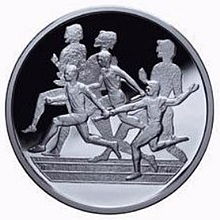- Dolichos (running race)
-
- For other uses , see Dolichos
Dolichos or Dolichus (Greek: Δόλιχος, English translation: "long race") in ancient Olympics was a long-race (ca. 4800 m) introduced in 720 BC. Separate accounts of the race present conflicting evidence as to the actual length of the dolichos. However, the average stated length of the race was approximately 18-24 laps, or about three miles. The event was run similarly to modern marathons - the runners would begin and end their event in the stadium proper, but the race course would wind its way through the Olympic grounds. The course would often flank important shrines and statues in the sanctuary, passing by the Nike statue by the temple of Zeus before returning to the stadium.[1][2]
Contents
Winners
- Acanthus of Sparta 720 BC
- Ergoteles of Himera 472 BC
- Ladas of Argos 460 BC
- Aristeus of Argos 420 BC
- Malacus of Macedonia 329 BC
- Aegeus of Argos 328 BC
- Polites of Ceramus 69 AD
Dolichos on coinage
Dolichos events have been selected as a main motif in numerous collectors' coins. One of the recent samples is the €10 Greek Relays commemorative coin, minted in 2003 to commemorate the 2004 Summer Olympics. In the obverse of the coin three modern athletes run, holding their batons while in the background three ancient athletes are shown running a dolichos (a semi-endurance race of approximately 3800 meters distance).
References
- ^ Golden, p. 55. "Dolichos, "long race", one of the regular events of Greek competitive festivals. The dolichos varied in length from seven to twenty-four lengths of the STADIUM - from 1,400 to 4,800 Greek feet. The race at Olympia was apparently one of the longest; only men ran here - the first winner, in 720, was ACANTHUS of Sparta. However, dolichos was on the original programme for paides as well as men at the Pythian games and is attested at Nemea too. The dolichos for younger competitors may have been shorter (like all the footraces for boys and AGENEIOI Plato planned for his Cretan city). A horse (says Galen) would run dolichos better than a man. Among men, the ideal was a strong neck and shoulders - to hold up the hands during most of the race - and light, slender legs for a finishing sprint. A Bithynian nicknamed GRAUS won the Olympic dolichos three times in a row (? 213-221 CE) and FLAVIUS Metrobius claims 140 victories in the late first century CE. The achievement of POLITES of Caria, who won STADION, DIAULOS and dolichos on the same day at Olympia (69 BC), was as remarkable."
- ^ Miller, p. 32. "At the next Olympiad, in 720, a long-distance footrace called the dolichos was added to the program. The sources are not unanimous about the length of this race: some claim that it was twenty laps of the stadium track, others that it was twenty-four. It may have differed from site to site, but it was in the range of 7.5 to 9 kilometers. We can identify a dolichos in paintings where the runners' knees are low and barely bent, with the arms drawn close to the sides."
Sources
- Golden, Mark. Sport in the Ancient World from A to Z. Routledge, 2003. ISBN 0415248817
- Miller, Stephen G. Ancient Greek Athletics: the events at Olympia, Delphi, Nemea, and Isthmia. Yale University Press, 2004. ISBN 0300115296

This athletics and track and field article is a stub. You can help Wikipedia by expanding it.

